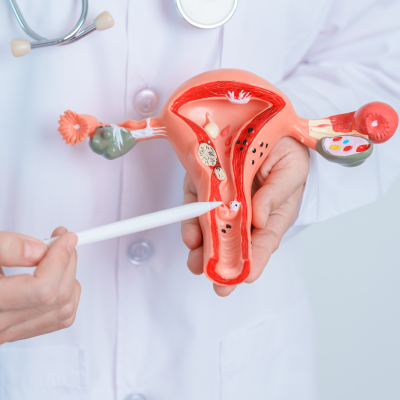Fibroids
Fibroids are compact tumors made of smooth muscle cells and fibrous connective tissue that attach themselves to the inside of the uterus. They are the most frequently seen tumors of the female reproductive system, and may range from the size of a pea to the size of a softball or small grapefruit, or even larger.
An estimated 20%-50% of females of reproductive age have fibroids, although not all are diagnosed. An estimated 30%-77% of females will develop fibroids sometime during their childbearing years, although, only about 30% of these fibroids are large enough to be detected by a healthcare provider during a physical examination.
In more than 99% of fibroid cases, the tumors are benign (non-cancerous) and do not increase the risk for uterine cancer.
While the cause is not clearly understood, it is believed that each tumor develops from an aberrant muscle cell in the uterus, which multiplies rapidly because of the influence of estrogen.
Symptoms and Risks
Individuals who are approaching menopause are at the greatest risk for fibroids because of their long exposure to high levels of estrogen. Patients who are obese and/or of African American descent have an increased risk of developing fibroid tumors.
Symptoms vary widely between individuals. Some females may have mild symptoms or no symptoms at all, while others have more severe, disruptive symptoms.
The most common fibroid symptoms include:
- Heavy or prolonged menstrual periods
- Abnormal bleeding between menstrual periods
- Pelvic pain
- Frequent urination
- Low back pain
- Pain during intercourse
- Infertility
- Anemia
- A firm mass, usually near the middle of the pelvis
Heavy or prolonged menstrual periods, or abnormal bleeding between periods, can lead to iron-deficiency anemia, which will also require treatment in some patients.
Diagnosis
Fibroids are most often found during a routine pelvic examination. This, along with an abdominal examination by your physician, may detect a firm, irregular pelvic mass.
Other fibroid diagnostic procedures include:
- Transvaginal ultrasound (also called ultrasonography): An ultrasound test which uses a small instrument called a transducer that is placed in the vagina
- Magnetic resonance imaging (MRI), often used by Interventional Radiologists
- Hysterosalpingography: An X-ray examination of the uterus and fallopian tubes that uses dye and is often performed to rule out tubal obstruction
- Hysteroscopy: Visual examination of the canal of the cervix and the interior of the uterus using a hysteroscope inserted through the vagina
- Blood test: Used to check for iron-deficiency anemia if the tumor causes heavy bleeding
Treatments
Treatment for fibroids can range from no treatment at all to surgery. Many times, treatment isn't necessary unless fibroids are causing excessive bleeding, discomfort or infertility.
The following are treatment options for fibroids:
Nonsurgical Options
Medications
Medications are available that can temporarily improve symptoms, particularly heavy bleeding. They also may shrink the fibroids by a small amount. However, they do not make the fibroids go away.
GnRH Agonists
GnRH agonists are a class of medications that temporarily shrink fibroids and stop heavy bleeding by blocking production of the female hormone, estrogen. These drugs are recommended only for very specific cases. They may be recommended if you have heavy bleeding and serious anemia.Intrauterine Devices (IUD)
An IUD that releases a small amount of hormone into the uterine cavity can decrease bleeding caused by fibroids.
Surgical Options
Myomectomy
For individuals who have fibroid symptoms and want to have children in the future, myomectomy is the best treatment option as this operation removes fibroids while preserving the uterus. Keep in mind — fibroids can re-grow. Your age at the time of surgery and the number of fibroids you have affect whether you develop fibroids again in the future.
A myomectomy can be performed several different ways, depending on the size, number and location of your fibroids. Many can be performed laparoscopically.
Hysterectomy
Hysterectomy is a major surgical procedure in which the uterus is removed. After this procedure, new fibroids cannot grow. Symptoms improve as well. However, a person can no longer become pregnant after a hysterectomy.
There are several hysterectomy surgical approaches: a vaginal hysterectomy, an abdominal hysterectomy and a laparoscopic hysterectomy. The choice of procedure will depend on the size of the uterus and several other factors.
Laparoscopic radiofrequency ablation
Laparoscopic radiofrequency ablation of fibroids (also referred to as the Acessa procedure) is a procedure that uses heat to destroy fibroid tissue. Your surgeon places a camera through two small surgical cuts: one in the belly button and one in the skin over the lower abdomen, looks inside your abdomen and inserts small instruments to destroy the fibroids with heat and energy.
Individuals may want to pursue this surgery for a variety of reasons:
- It saves the uterus.
- This laparoscopic procedure provides a faster recovery than traditional abdominal surgery done through a large incision.
For more information on fibroids, schedule an appointment for a pelvic exam with a Summa Health physician in the Akron area or call 330.869.9777

Fibroids 101: Facts, Causes and Treatment Options [Podcast]
Dr. Megan Cesta to discuss all things Fibroids. Facts, Causes and Treatment Options.
